| Listing 1 - 10 of 26 | << page >> |
Sort by
|
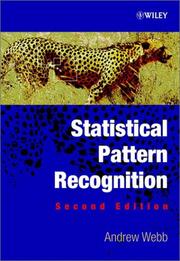
ISBN: 0470845147 0470845139 9780470845141 9780470845134 Year: 2003 Publisher: Chichester Wiley
Abstract | Keywords | Export | Availability | Bookmark
 Loading...
Loading...Choose an application
- Reference Manager
- EndNote
- RefWorks (Direct export to RefWorks)
Mathematical statistics --- Pattern perception --- Statistical methods --- Statistical methods. --- data collection --- Data analysis --- Grading --- Network analysis --- computer applications --- Design perception --- Pattern recognition --- Form perception --- Perception --- Figure-ground perception --- Pattern recognition systems --- Reconnaissance des formes (Informatique) --- Méthodes statistiques --- Pattern perception - Statistical methods --- Algorithme
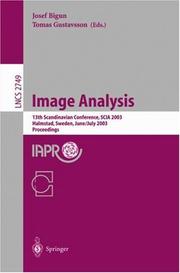
ISBN: 354045103X 3540406018 Year: 2003 Publisher: Berlin, Heidelberg : Springer Berlin Heidelberg : Imprint: Springer,
Abstract | Keywords | Export | Availability | Bookmark
 Loading...
Loading...Choose an application
- Reference Manager
- EndNote
- RefWorks (Direct export to RefWorks)
Image processing --- Applied Physics --- Engineering & Applied Sciences --- Computer science. --- Science. --- Computer graphics. --- Image processing. --- Pattern recognition. --- Computer Science. --- Image Processing and Computer Vision. --- Science, general. --- Computer Graphics. --- Pattern Recognition. --- Computer vision. --- Optical pattern recognition. --- Science, Humanities and Social Sciences, multidisciplinary. --- Optical data processing --- Pattern perception --- Perceptrons --- Visual discrimination --- Automatic drafting --- Graphic data processing --- Graphics, Computer --- Computer art --- Graphic arts --- Electronic data processing --- Engineering graphics --- Machine vision --- Vision, Computer --- Artificial intelligence --- Pattern recognition systems --- Digital techniques --- Optical data processing. --- Design perception --- Pattern recognition --- Form perception --- Perception --- Figure-ground perception --- Optical computing --- Visual data processing --- Bionics --- Integrated optics --- Photonics --- Computers --- Optical equipment
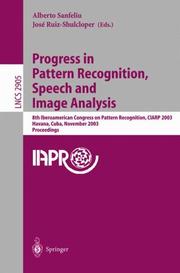
ISBN: 9783540205906 354020590X 9783540245865 9786610307968 128030796X 3540245863 Year: 2003 Publisher: Berlin, Heidelberg : Springer Berlin Heidelberg : Imprint: Springer,
Abstract | Keywords | Export | Availability | Bookmark
 Loading...
Loading...Choose an application
- Reference Manager
- EndNote
- RefWorks (Direct export to RefWorks)
CIARP 2003 (8th Iberoamerican Congress on Pattern Recognition) was the eighth event in a series of pioneering congresses on pattern recognition in the Latin American c- munity of countries. This year, however, the forum was extended to include worldwide participation. The event has been held in the past in Mexico, Cuba, Brazil and Por- gal; it took place this year in Havana (Cuba). The aim of the congress was to promote and disseminate ongoing research into mathematical methods for pattern recognition, computer vision, image analysis, and speech recognition, as well as the application of these techniques in such diverse areas as robotics, industry, health, entertainment, space exploration, telecommunications, data mining, document analysis, and natural language processing and recognition to name a few. Moreover it was a forum for scienti?c re- arch, experience exchange, the sharing of new knowledge, and establishing contacts to improve cooperation between research groups in pattern recognition, computer vision and related areas. The congress was organized by the Institute of Cybernetics, Mathematics and P- sics of Cuba (ICIMAF) and the Center for Computing Research (CIC) of the National Polytechnic Institute of Mexico, and was sponsored by the University of La Salle, - xico, the University of Oriente, Cuba, the Polytechnic Institute “Jose ´ A.
Pattern recognition systems --- Image processing --- Reconnaissance des formes (Informatique) --- Traitement d'images --- Congresses. --- Congrès --- Computer science. --- Artificial intelligence. --- Computer vision. --- Optical pattern recognition. --- Computer Science. --- Pattern Recognition. --- Artificial Intelligence (incl. Robotics). --- Image Processing and Computer Vision. --- Electrical & Computer Engineering --- Engineering & Applied Sciences --- Electrical Engineering --- Image processing. --- Pattern recognition. --- Artificial Intelligence. --- AI (Artificial intelligence) --- Artificial thinking --- Electronic brains --- Intellectronics --- Intelligence, Artificial --- Intelligent machines --- Machine intelligence --- Thinking, Artificial --- Bionics --- Cognitive science --- Digital computer simulation --- Electronic data processing --- Logic machines --- Machine theory --- Self-organizing systems --- Simulation methods --- Fifth generation computers --- Neural computers --- Optical data processing --- Pattern perception --- Perceptrons --- Visual discrimination --- Machine vision --- Vision, Computer --- Artificial intelligence --- Optical data processing. --- Optical computing --- Visual data processing --- Integrated optics --- Photonics --- Computers --- Design perception --- Pattern recognition --- Form perception --- Perception --- Figure-ground perception --- Optical equipment
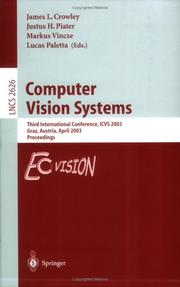
ISBN: 3540009213 3540365923 Year: 2003 Publisher: Berlin : Springer,
Abstract | Keywords | Export | Availability | Bookmark
 Loading...
Loading...Choose an application
- Reference Manager
- EndNote
- RefWorks (Direct export to RefWorks)
This book constitutes the refereed proceedings of the Third International Conference on Computer Vision Systems, ICVS 2003, held in Graz, Austria, in April 2003. The 51 revised full papers presented were carefully reviewed and selected from 109 submissions. The papers are organized in topical sections on cognitive vision, philosophical issues in cognitive vision, cognitive vision and applications, computer vision architectures, performance evaluation, implementation methods, architecture and classical computer vision, and video annotation.
Computer vision --- Applied Physics --- Engineering & Applied Sciences --- Computer science. --- Software engineering. --- Artificial intelligence. --- Computer graphics. --- Image processing. --- Pattern recognition. --- Computer Science. --- Image Processing and Computer Vision. --- Software Engineering. --- Artificial Intelligence (incl. Robotics). --- Computer Graphics. --- Pattern Recognition. --- Computer vision. --- Optical pattern recognition. --- Artificial Intelligence. --- Optical data processing --- Pattern perception --- Perceptrons --- Visual discrimination --- Automatic drafting --- Graphic data processing --- Graphics, Computer --- Computer art --- Graphic arts --- Electronic data processing --- Engineering graphics --- Image processing --- AI (Artificial intelligence) --- Artificial thinking --- Electronic brains --- Intellectronics --- Intelligence, Artificial --- Intelligent machines --- Machine intelligence --- Thinking, Artificial --- Bionics --- Cognitive science --- Digital computer simulation --- Logic machines --- Machine theory --- Self-organizing systems --- Simulation methods --- Fifth generation computers --- Neural computers --- Computer software engineering --- Engineering --- Machine vision --- Vision, Computer --- Artificial intelligence --- Pattern recognition systems --- Digital techniques --- Optical data processing. --- Design perception --- Pattern recognition --- Form perception --- Perception --- Figure-ground perception --- Optical computing --- Visual data processing --- Integrated optics --- Photonics --- Computers --- Optical equipment
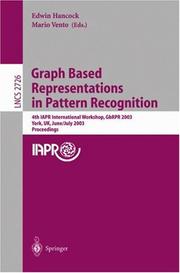
ISBN: 3540450289 354040452X Year: 2003 Publisher: Berlin, Heidelberg : Springer Berlin Heidelberg : Imprint: Springer,
Abstract | Keywords | Export | Availability | Bookmark
 Loading...
Loading...Choose an application
- Reference Manager
- EndNote
- RefWorks (Direct export to RefWorks)
This volume contains the papers presented at the Fourth IAPR Workshop on Graph Based Representations in Pattern Recognition. The workshop was held at the King’s Manor in York, England between 30 June and 2nd July 2003. The previous workshops in the series were held in Lyon, France (1997), Haindorf, Austria (1999), and Ischia, Italy (2001). The city of York provided an interesting venue for the meeting. It has been said that the history of York is the history of England. There have been both Roman and Viking episodes. For instance, Constantine was proclaimed emperor in York. The city has also been a major seat of ecclesiastical power and was also involved in the development of the railways in the nineteenth century. Much of York’s history is evidenced by its buildings, and the King’s Manor is one of the most important and attractive of these. Originally part of the Abbey, after the dissolution of the monasteries by Henry VIII, the building became a center of government for the Tudors and the Stuarts (who stayed here regularly on their journeys between London and Edinburgh), serving as the headquarters of the Council of the North until it was disbanded in 1561. The building became part of the University of York at its foundation in 1963. The papers in the workshop span the topics of representation, segmentation, graph-matching, graph edit-distance, matrix and spectral methods, and gra- clustering.
Optical pattern recognition --- Graph theory --- Applied Physics --- Engineering & Applied Sciences --- Data processing --- Graphs, Theory of --- Theory of graphs --- Extremal problems --- Computer science. --- Science. --- Data structures (Computer science). --- Computer science --- Computer graphics. --- Pattern recognition. --- Computer Science. --- Pattern Recognition. --- Science, general. --- Computer Science, general. --- Data Structures. --- Discrete Mathematics in Computer Science. --- Computer Graphics. --- Mathematics. --- Combinatorial analysis --- Topology --- Optical pattern recognition. --- Data structures (Computer scienc. --- Computational complexity. --- Science, Humanities and Social Sciences, multidisciplinary. --- Automatic drafting --- Graphic data processing --- Graphics, Computer --- Computer art --- Graphic arts --- Electronic data processing --- Engineering graphics --- Image processing --- Complexity, Computational --- Machine theory --- Informatics --- Science --- Optical data processing --- Pattern perception --- Perceptrons --- Visual discrimination --- Digital techniques --- Computer science—Mathematics. --- Information structures (Computer science) --- Structures, Data (Computer science) --- Structures, Information (Computer science) --- File organization (Computer science) --- Abstract data types (Computer science) --- Design perception --- Pattern recognition --- Form perception --- Perception --- Figure-ground perception
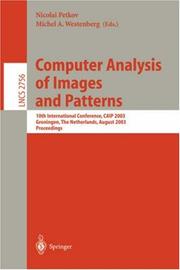
ISBN: 354045179X 3540407308 Year: 2003 Publisher: Berlin, Heidelberg : Springer Berlin Heidelberg : Imprint: Springer,
Abstract | Keywords | Export | Availability | Bookmark
 Loading...
Loading...Choose an application
- Reference Manager
- EndNote
- RefWorks (Direct export to RefWorks)
This volume presents the proceedings of the 10th International Conference on Computer Analysis of Images and Patterns (CAIP 2003). This conference - ries started about 18 years ago in Berlin. Initially, the conference served as a forum for meetings between scientists from Western- and Eastern-bloc co- tries. Nowadays, the conference attracts participants from all over the world. The conference gives equal weight to posters and oral presentations, and the selected presentation mode is based on the most appropriate communication medium. The programme follows a single-track format, rather than parallel s- sions. Non-overlapping oral and poster sessions ensure that all attendees have the opportunity to interact personally with presenters. As for the numbers, we received a total of 160 submissions. All papers were reviewed by two to three members of the Programme Committee. The ?nal - lection was carried out by the Conference Chairs. Out of the 160 papers, 42 were selected for oral presentation and 52 as posters. At this point, we wish to thank the Programme Committee and additional referees for their timely and high-quality reviews. The paper submission and review procedure was carried out electronically. We thank Marcin Morg´ os from Scalar–IT Solutions for p- viding us with the Web-based participant registration system. We also thank the invited speakers Nicholas Ayache, John Daugman, and Dariu Gavrila, for kindly accepting our invitation.
Image processing --- Computer vision --- Optical pattern recognition --- Applied Physics --- Engineering & Applied Sciences --- Digital techniques --- Computer science. --- Science. --- Text processing (Computer science). --- Computer graphics. --- Image processing. --- Pattern recognition. --- Computer Science. --- Image Processing and Computer Vision. --- Science, general. --- Document Preparation and Text Processing. --- Computer Graphics. --- Pattern Recognition. --- Computer vision. --- Natural language processing (Computer science). --- Optical pattern recognition. --- Science, Humanities and Social Sciences, multidisciplinary. --- Natural Language Processing (NLP). --- Optical data processing --- Pattern perception --- Perceptrons --- Visual discrimination --- Automatic drafting --- Graphic data processing --- Graphics, Computer --- Computer art --- Graphic arts --- Electronic data processing --- Engineering graphics --- NLP (Computer science) --- Artificial intelligence --- Human-computer interaction --- Semantic computing --- Machine vision --- Vision, Computer --- Pattern recognition systems --- Optical data processing. --- Design perception --- Pattern recognition --- Form perception --- Perception --- Figure-ground perception --- Optical computing --- Visual data processing --- Bionics --- Integrated optics --- Photonics --- Computers --- Optical equipment
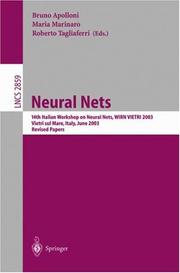
ISBN: 3540452168 3540202277 Year: 2003 Publisher: Berlin, Heidelberg : Springer Berlin Heidelberg : Imprint: Springer,
Abstract | Keywords | Export | Availability | Bookmark
 Loading...
Loading...Choose an application
- Reference Manager
- EndNote
- RefWorks (Direct export to RefWorks)
Neural networks (Computer science) --- Computer Science --- Engineering & Applied Sciences --- Computer science. --- Microprocessors. --- Computers. --- Mathematical statistics. --- Artificial intelligence. --- Pattern recognition. --- Bioinformatics. --- Computer Science. --- Artificial Intelligence (incl. Robotics). --- Computation by Abstract Devices. --- Processor Architectures. --- Probability and Statistics in Computer Science. --- Pattern Recognition. --- Optical pattern recognition. --- Artificial Intelligence. --- Bio-informatics --- Biological informatics --- Biology --- Information science --- Computational biology --- Systems biology --- Optical data processing --- Pattern perception --- Perceptrons --- Visual discrimination --- Informatics --- Science --- AI (Artificial intelligence) --- Artificial thinking --- Electronic brains --- Intellectronics --- Intelligence, Artificial --- Intelligent machines --- Machine intelligence --- Thinking, Artificial --- Bionics --- Cognitive science --- Digital computer simulation --- Electronic data processing --- Logic machines --- Machine theory --- Self-organizing systems --- Simulation methods --- Fifth generation computers --- Neural computers --- Data processing --- Design perception --- Pattern recognition --- Form perception --- Perception --- Figure-ground perception --- Mathematics --- Statistical inference --- Statistics, Mathematical --- Statistics --- Probabilities --- Sampling (Statistics) --- Minicomputers --- Automatic computers --- Automatic data processors --- Computer hardware --- Computing machines (Computers) --- Electronic calculating-machines --- Electronic computers --- Hardware, Computer --- Computer systems --- Cybernetics --- Calculators --- Cyberspace --- Statistical methods
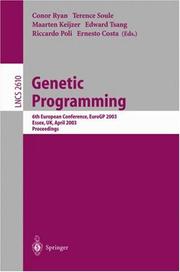

ISBN: 3540365990 354000971X Year: 2003 Publisher: Berlin, Heidelberg : Springer Berlin Heidelberg : Imprint: Springer,
Abstract | Keywords | Export | Availability | Bookmark
 Loading...
Loading...Choose an application
- Reference Manager
- EndNote
- RefWorks (Direct export to RefWorks)
In this volume we present the accepted contributions to the Sixth European Conference on Genetic Programming (EuroGP 2003) which took place at the University of Essex, UK on 14-16 April 2003. EuroGP is now a well-established conference and, without any doubt, the most important international event - voted to Genetic Programming occurring in Europe. The proceedings have all been published by Springer-Verlag in the LNCS series. EuroGP began as an - ternational workshop in Paris, France in 1998 (14–15 April, LNCS 1391). Sub- quently the workshop was held in G¨ oteborg, Sweden in 1999 (26–27 May, LNCS 1598) and then EuroGP became an annual conference: in 2000 in Edinburgh, UK (15–16 April, LNCS 1802), in 2001 in Lake Como, Italy (18–19 April, LNCS 2038) and in 2002 in Kinsale, Ireland (3–5 April, LNCS 2278). From the outset, there have always been specialized workshops, co-located with EuroGP, focusing on applications of evolutionary algorithms (LNCS 1468, 1596, 1803, 2037, and 2279). This year was no exception and EvoWorkshops 2003, incorporating Evo- BIO, EvoCOP, EvoIASP, EvoMUSART, EvoSTIM and EvoROB, took place at the University of Essex (LNCS 2611). Genetic Programming (GP) is that part of Evolutionary Computation which solves particular complex problems or tasks by evolving and adapting popu- tions of computer programs, using Darwinian evolution and Mendelian genetics as a source of inspiration.
Genetic programming (Computer science) --- Computer Science --- Engineering & Applied Sciences --- Computer science. --- Computer programming. --- Computers. --- Algorithms. --- Artificial intelligence. --- Pattern recognition. --- Bioinformatics. --- Computer Science. --- Artificial Intelligence (incl. Robotics). --- Programming Techniques. --- Computation by Abstract Devices. --- Algorithm Analysis and Problem Complexity. --- Pattern Recognition. --- Computer programming --- Genetic algorithms --- Computer software. --- Optical pattern recognition. --- Artificial Intelligence. --- Bio-informatics --- Biological informatics --- Biology --- Information science --- Computational biology --- Systems biology --- Optical data processing --- Pattern perception --- Perceptrons --- Visual discrimination --- Software, Computer --- Computer systems --- Informatics --- Science --- AI (Artificial intelligence) --- Artificial thinking --- Electronic brains --- Intellectronics --- Intelligence, Artificial --- Intelligent machines --- Machine intelligence --- Thinking, Artificial --- Bionics --- Cognitive science --- Digital computer simulation --- Electronic data processing --- Logic machines --- Machine theory --- Self-organizing systems --- Simulation methods --- Fifth generation computers --- Neural computers --- Data processing --- Design perception --- Pattern recognition --- Form perception --- Perception --- Figure-ground perception --- Algorism --- Algebra --- Arithmetic --- Automatic computers --- Automatic data processors --- Computer hardware --- Computing machines (Computers) --- Electronic calculating-machines --- Electronic computers --- Hardware, Computer --- Cybernetics --- Calculators --- Cyberspace --- Computers --- Electronic computer programming --- Electronic digital computers --- Programming (Electronic computers) --- Coding theory --- Foundations --- Programming
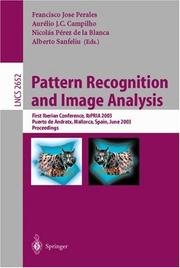
ISBN: 3540448713 3540402179 Year: 2003 Publisher: Berlin, Heidelberg : Springer Berlin Heidelberg : Imprint: Springer,
Abstract | Keywords | Export | Availability | Bookmark
 Loading...
Loading...Choose an application
- Reference Manager
- EndNote
- RefWorks (Direct export to RefWorks)
Optical pattern recognition --- Image processing --- Computer vision --- Applied Physics --- Engineering & Applied Sciences --- Computer science. --- Artificial intelligence. --- Text processing (Computer science). --- Image processing. --- Pattern recognition. --- Computer Science. --- Pattern Recognition. --- Image Processing and Computer Vision. --- Artificial Intelligence (incl. Robotics). --- Document Preparation and Text Processing. --- Optical pattern recognition. --- Computer vision. --- Natural language processing (Computer science). --- Artificial Intelligence. --- Natural Language Processing (NLP). --- NLP (Computer science) --- Artificial intelligence --- Electronic data processing --- Human-computer interaction --- Semantic computing --- AI (Artificial intelligence) --- Artificial thinking --- Electronic brains --- Intellectronics --- Intelligence, Artificial --- Intelligent machines --- Machine intelligence --- Thinking, Artificial --- Bionics --- Cognitive science --- Digital computer simulation --- Logic machines --- Machine theory --- Self-organizing systems --- Simulation methods --- Fifth generation computers --- Neural computers --- Machine vision --- Vision, Computer --- Pattern recognition systems --- Optical data processing --- Pattern perception --- Perceptrons --- Visual discrimination --- Optical data processing. --- Optical computing --- Visual data processing --- Integrated optics --- Photonics --- Computers --- Design perception --- Pattern recognition --- Form perception --- Perception --- Figure-ground perception --- Optical equipment
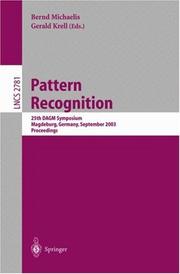
ISBN: 3540408614 3540452435 Year: 2003 Publisher: Berlin, Heidelberg : Springer Berlin Heidelberg : Imprint: Springer,
Abstract | Keywords | Export | Availability | Bookmark
 Loading...
Loading...Choose an application
- Reference Manager
- EndNote
- RefWorks (Direct export to RefWorks)
Image processing --- Optical pattern recognition --- Digital techniques --- Computer science. --- Artificial intelligence. --- Computer graphics. --- Image processing. --- Pattern recognition. --- Computer Science. --- Pattern Recognition. --- Artificial Intelligence (incl. Robotics). --- Computer Graphics. --- Image Processing and Computer Vision. --- Optical pattern recognition. --- Computer vision. --- Artificial Intelligence. --- Machine vision --- Vision, Computer --- Artificial intelligence --- Pattern recognition systems --- Automatic drafting --- Graphic data processing --- Graphics, Computer --- Computer art --- Graphic arts --- Electronic data processing --- Engineering graphics --- AI (Artificial intelligence) --- Artificial thinking --- Electronic brains --- Intellectronics --- Intelligence, Artificial --- Intelligent machines --- Machine intelligence --- Thinking, Artificial --- Bionics --- Cognitive science --- Digital computer simulation --- Logic machines --- Machine theory --- Self-organizing systems --- Simulation methods --- Fifth generation computers --- Neural computers --- Optical data processing --- Pattern perception --- Perceptrons --- Visual discrimination --- Optical data processing. --- Optical computing --- Visual data processing --- Integrated optics --- Photonics --- Computers --- Design perception --- Pattern recognition --- Form perception --- Perception --- Figure-ground perception --- Optical equipment
| Listing 1 - 10 of 26 | << page >> |
Sort by
|

 Search
Search Feedback
Feedback About UniCat
About UniCat  Help
Help News
News